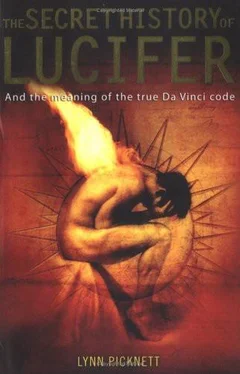However, although in many ways his contribution to human knowledge and to the annals of heresy was unique, Leonardo was merely the bright blossoming of an ancient tradition of working behind closed doors, away from misunderstanding, the rack and the stake. Usually these secretive scholars were known as `alchemists', a sort of convenient umbrella term for what we would acknowledge simply as research scientists. Alchemy proper, however, was a complex business, often involving mystical and spiritual exercises, with a strong sexual content: once again, we discuss that sacred sexuality is the background to an eminent esoteric tradition 56
True alchemists often positively welcomed their bad reputation as idiotic charlatans who insanely wasted their lives attempting to turn base metal such as lead into pure gold. To be dismissed as one of these empty-headed materialistic `puffers' could mean being left alone to concentrate on much weightier matters such as searching for the fabled Philosopher's Stone, an elixir that would bestow not only near-immortality, but also supreme spiritual knowledge and wisdom. Every child the world over today knows that one Nicholas Flamel is rumoured to have found this magical substance, thanks to J. K. Rowling's Harry Potter books, but few realize that he really existed. Flamel lived and worked in fourteenth-century Paris with his beloved wife Perrenelle, with whom it is said he achieved the `Great Work' on 17 January 1382. As a result, rumours still abound that they lived for hundreds of years.
While it is untrue that all popes were equally anti-learning as far as the laity was concerned, the activities of most alchemists were deemed to be inherently beyond the pale. Many sought not only to transmute base metal - be it their own souls or a heap of uninspiring lead - into something purer and finer, but some attempted to blast through all restrictions and enter the truly Luciferan world of creating life in the laboratory. Stories circulated about the original `test-tube babies', said to be unholy little homunculi, created without the usual procreation specifically to scurry around to do their master's bidding as occult servitors. Needless to say, the homunculi were, at least in the vast majority of alleged cases, the product of over-heated imaginations, but it does reveal that scientists condemned for trying to `play God' are not unique to the twenty-first century.
However, the great physician and alchemist/sorcerer Aureolus Philippus Theophrastus Bombast von Hohenheim - otherwise known simply as Paracelsus (1493-1541) - declared boldly `It is necessary to know evil things as well as good; for who can know what is good without also knowing what is evil?'s' An active Luciferan in this sense, he claimed to have actually made several such little monsters using a process he described as follows:
Let the semen of a man putrefy by itself in a sealed cucurbite with the highest putrefaction of venter equinus for forty days, or until it begins at last to live, move, and be agitated, which can easily be seen. At this time it will be in some degree like a human being, but, nevertheless, transparent and without a body. If now, after this, it be every day nourished and fed cautiously with the arcanum of human blood, and kept for forty weeks in the perpetual and equal heat of venter equinus, it becomes thencefold a true living human infant, having all the members of a child that is born from a woman, but much smaller. This we call a homunculus; and it should be afterwards educated with the greatest care and zeal, until it grows up and starts to display intelligence."
(Sceptics would no doubt point out that some movement was virtually guaranteed in putrefying matter after a certain time - but from nothing more occult than maggots.)
In 1658, Gian Battista della Porta, the sorcerer who was arrested for projecting images using a magic lantern (see above), proposed to show `how living Creatures of divers kinds, may be mingled and coupled together, and that from them, new, and yet profitable kinds of living Creatures may be generated.'S9 Della Porta aimed to produce through magical means all sorts of animate gimmicks, writing instructions on `how to generate pretty little dogs to play with'.60 However, Paracelsus saw a greater practical potential in the little homunculi, writing:
Now, this is one of the greatest secrets which God has revealed to mortal and fallible man. It is a miracle and a marvel of God, an arcanum above all arcana, and deserves to be kept secret until the last of times, when there shall be nothing hidden, but all things shall be manifest. And although up to this time it has not been known to men, it was, nevertheless, known to the woodsprites and nymphs and giants long ago, because they themselves were sprung from this source; since from such homunculi when they come to manhood are produced giants, pygmies and other marvellous people, who get great victories over their enemies, and know all secrets and hidden matters 61
Even the great Paracelsus clearly had areas of his imagination that were still marked, as on the old maps, `Here there be Dragons'. It was said that he willed that when he became old, he would be cut into small pieces and buried in horse manure in order to resurrect as a virile young man. Unfortunately, his servant dug him up too soon, and ruined the marvellous plan.
As the self-styled `Christ of Medicine"' - he also gave one of his names to the word `bombastic', because of his overbearing manner. Paracelsus studied alchemy and chemistry at Basle University before researching minerals, metals and the occupational diseases of miners. Because he believed that `like acts on like' in minute doses, he is credited with the discovery of homeopathy, as well as inventing `ether as an anaesthetic and laudanum as a tranquillizer' [and] he was the first to describe silicosis, and `traced goitre to minerals found in drinking water'.63 Announcing `If the spirit suffers, the body suffers also', he was also clearly a pioneer of what we would call holistic medicine. A major influence on subsequent generations of physicians, even his ideas about homunculi were taken seriously.
In 1638 Laurens de Castelan made the point in his `Rare et Curieux Discours de ]a Plante Appelee Mandragore' that although most people rejected Paracelsus' theories his homunculus could still have been `a bit of diabolical magic' - in other words, it may have been real, but created by devilish means. In 1672 the scientist Christian Friedrich Garmann wrote of the evolution of the human egg, musing about the possibility that conception could take place outside the womb, in an article about `the chemical homunculus of Paracelsus' M And in 1679 Scottish doctor William Maxwell wrote in his De Medicina Magnetica that `just as salts of herbs can reproduce the likeness of the herb in the test tube, so the salt of human blood can show the image of a man - "the true homunculus of Paracelsus".'65
It may be significant that it was also claimed to be possible to grow magical, sentient entities inside the wombs of cows. Leonardo's drawing of a perfectly formed human baby curled up inside a cow's uterus has always been dismissed as a typical Da Vinci joke - presumably at the expense of women. Perhaps it was a sly dig at the sanctity of motherhood, but perhaps it was also a comment, satirical or even admiring, on the magical concept of homunculi. Leonardo's own lifelike creations - at least those we know about - took the less creepy form of a robot, a true working humanoid automaton, which he built c. 1495.11 Dressed in a full suit of armour, it was designed to open and close its mouth, move its head, sit up and wave its arms, and `may have made sounds to the accompaniment of automated drums' 67 Leonardo's pioneering work with robots directly inspired Mark Rosheim's `mechanical men' or `anthrobots', and whose work `has culminated in the electric 43-axis Robotic Surrogate built for NASA Johnson Space Center and intended to service Space Station Freedom. Thus, Leonardo's vision reaches beyond the confines of our planet to explore the universe.'6'
Читать дальше












